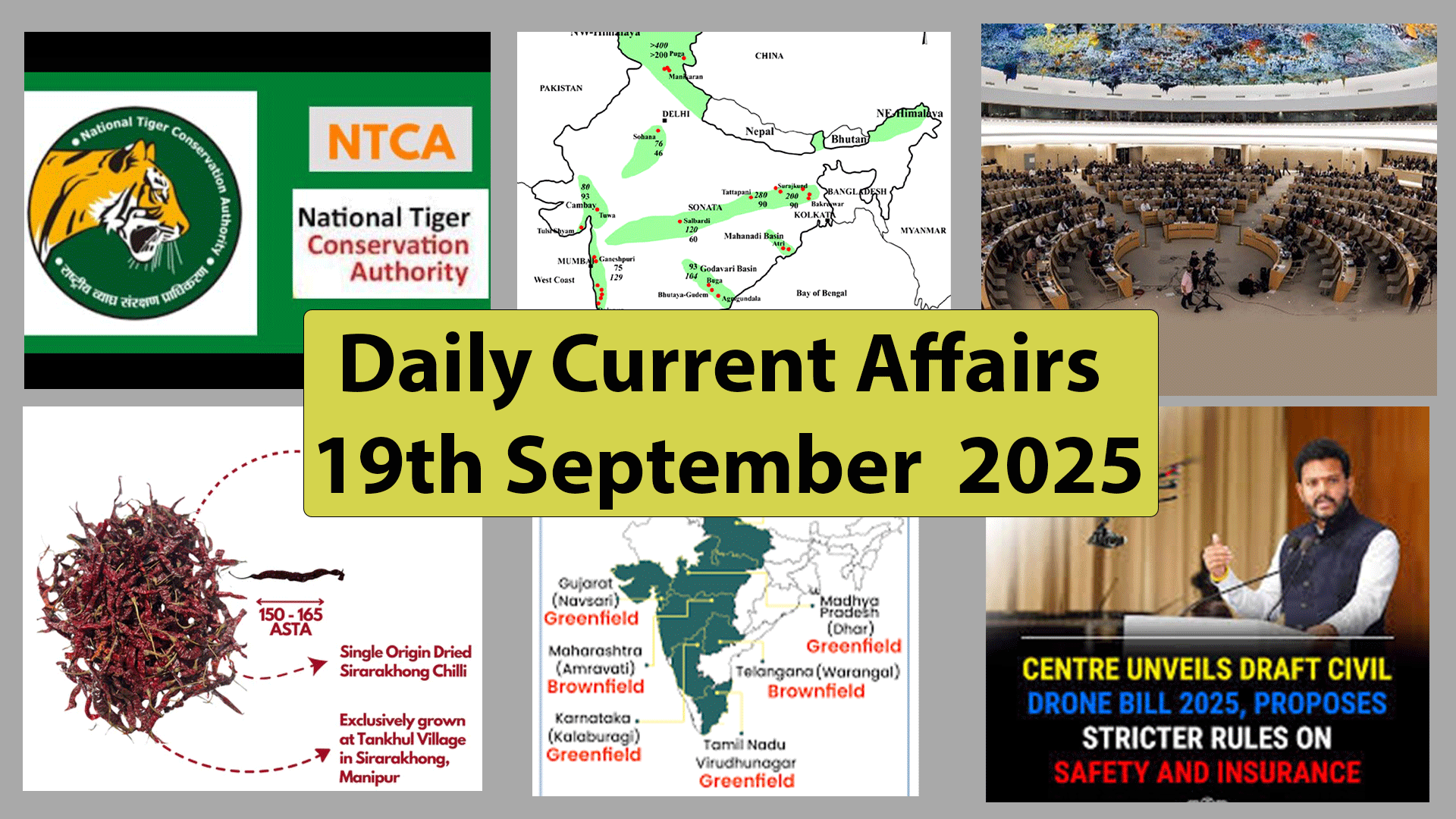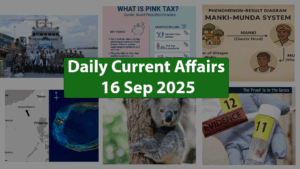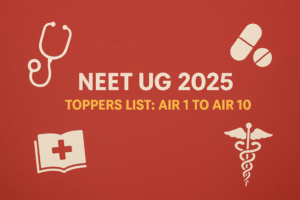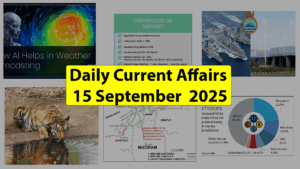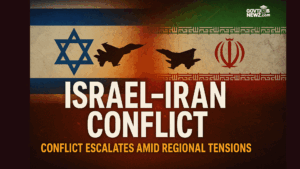Daily Current Affairs – 19 September 2025
Daily Current Affairs – 19 September 2025
An Quick Overview Of Daily Updates
The EU-India Strategic Roadmap
The European Union has unveiled a new EU-India Strategic Roadmap to boost cooperation in trade, technology, defence, connectivity, and climate action.
Introduction
- The European Union (EU) has announced a comprehensive new strategic roadmap with India, aimed at strengthening ties across trade, technology, defence, connectivity, and climate action.
- This initiative comes at a time of shifting global geopolitics and underscores the recognition of India as a vital partner for Europe in ensuring growth, security, and a rules-based global order.
- The roadmap seeks to elevate bilateral cooperation to a higher level, laying the groundwork for long-term engagement.
EU-India Strategic Roadmap: Background and Vision –
- The roadmap was unveiled by European Commission President Ursula von der Leyen.
- It is presented as part of the EU’s joint communication on a New Strategic EU-India Agenda, reflecting the bloc’s intent to deepen relations with India.
- The Commission emphasised the shared values and mutual benefits driving the partnership, noting that Europe is already India’s largest trading partner.
- It highlighted the aim to finalise the Free Trade Agreement (FTA) with India by the end of the year, which would become the largest deal of its kind globally.
- At the same time, EU officials acknowledged points of contention, such as India’s purchase of Russian oil and participation in Russian military exercises, which could pose challenges in advancing ties.
Key Areas of Cooperation –
- Trade and Economic Ties —
- The EU is India’s biggest trading partner and views the FTA as a central element of the roadmap.
- The strategy emphasises diversifying supply chains, enhancing investment flows, and fostering a conducive environment for business.
- The proposal includes the creation of an EU-India Business Forum to increase businessto-business engagement.
- Technology and Innovation —
- A strong focus has been placed on critical emerging technologies, digital transformation, and strengthening the EU-India Trade and Technology Council (TTC).
- Initiatives include deepening digital cooperation, supporting startups, and inviting India to associate with the Horizon Europe programme, aimed at research and innovation.
- Defence and Security Cooperation —
- The roadmap introduces a proposed EU-India Security and Defence Partnership, covering maritime security, cyber defence, crisis management, and counterterrorism.
- It suggests launching negotiations for a Security of Information Agreement to facilitate classified information exchange.
- The plan also emphasises strengthening defence industrial collaboration to boost technological capabilities and innovation.
- Connectivity and Global Governance —
- The roadmap highlights regional connectivity initiatives such as the India-Middle EastEurope Economic Corridor (IMEC) and trilateral cooperation projects under the EU Global Gateway.
- It prioritises cooperation in multilateral forums, promoting international law, and supporting global governance reforms.
- Labour mobility is also being addressed through a European Legal Gateway Office and a broader mobility cooperation framework covering study, work, and research opportunities. Climate Change and Sustainability —
- The agenda commits both sides to advancing climate action and clean energy cooperation, aligning with their shared global responsibility to combat climate change.
- Cooperation will also extend to sustainable development initiatives and green technologies.
India’s Response and Global Implications –
- PM Modi welcomed the roadmap, reaffirming India’s commitment to strengthening its partnership with the EU.
- He emphasised India’s stance on a peaceful resolution of the Ukraine conflict and reiterated his invitation for the next India-EU Summit to be hosted in India.
- The strategic roadmap reflects India’s growing global influence and the EU’s recognition of New Delhi as a critical partner in reshaping global economic and security architecture.
- Both sides acknowledge disagreements but underscore the broader alignment of interests in maintaining a rules-based international order.
Bima Sugam
Bima Sugam, envisioned as the world’s largest online insurance marketplace, was officially launched by the Bima Sugam India Federation (BSIF) at IRDAI’s Hyderabad headquarters.
The platform will roll out features in phases—starting as an information and guidance hub, with full-fledged transactions to follow as insurers and partners integrate. This phased approach aims to allow the insurance ecosystem time to adapt.
Bima Trinity: India’s Three-Pronged Insurance Strategy –
- Earlier, the central government, through IRDAI, had launched Bima Trinity to enhance insurance penetration by focusing on the three ‘A’s — availability, affordability, and accessibility.
- Components of Bima Trinity —
- Bima Sugam: A unified digital portal integrating insurers and distributors on one platform.
- Bima Vistaar: A comprehensive, affordable, all-in-one insurance product.
- Bima Vahak: A women-led field distribution network to expand reach.
Bima Sugam: India’s Unified Digital Insurance Marketplace –
- Launched by IRDAI, Bima Sugam is being hailed as a groundbreaking initiative, unmatched in scale worldwide.
- Unlike other countries’ digital channels, it offers a single, unified marketplace for all insurance needs—life, health, motor, travel, property, and agricultural policies—on one platform.
- Bima Sugam allows users to buy, sell, renew, manage, and claim insurance policies with ease and full transparency.
- Policy documents will be securely stored, ensuring easy access.
- It aims to do for insurance what UPI and NPCI have done for digital payments by creating common infrastructure for all stakeholders.
- The platform charges minimal fees and has all insurance companies as members, many of whom also hold equity stakes in the Bima Sugam India Federation (BSIF), which manages the system.
- Unlike private aggregators such as PolicyBazaar, which mainly distribute policies and earn high commissions, Bima Sugam offers end-to-end services including claim settlement, making it a low-cost, integrated, and transparent alternative.
Bima Sugam: A Milestone in India’s Digital Insurance Infrastructure –
- For the first time, insurers, agents, brokers, banks, and aggregators will operate under one platform, enabling customers to easily compare, purchase, and manage policies.
- It will also function as a centralised database to resolve queries and promote innovation by supporting new and sandbox products.
- Step Towards Digital Public Infrastructure —
- IRDAI hailed Bima Sugam as the first visible step in building India’s Digital Public Infrastructure (DPI) for insurance.
- This foundation aims to simplify access, increase transparency, and redefine how citizens secure financial protection.
- Empowering Policyholders and Expanding Coverage —
- Bima Sugam is a “critical step” toward insurance reform.
- It would empower policyholders, deepen penetration, and ensure fairness across the value chain, aligning with the national goal of Insurance for All by 2047 under Viksit Bharat 2047.
- With hundreds of insurance schemes available, customers often struggle to compare options. Bima Sugam will help them identify the most suitable plan transparently.
- Support for Insurers and Intermediaries —
- The portal will provide insurers real-time access to validated data and help agents/ intermediaries sell and service policies efficiently while reducing paperwork.
- Universalising and Democratising Insurance —
- Bima Sugam, designed as an electronic marketplace protocol, aims to make insurance universal and accessible.
- Linked with India Stack APIs, it ensures seamless delivery of digital services nationwide.
Bima Sugam: Wide-Ranging Insurance Offerings –
- Bima Sugam will host diverse life insurance products, including term plans, savings
(participating and non-participating), annuities, pensions, and ULIPs.
- It will also provide extensive health insurance solutions covering medical and wellness needs.
- The platform will offer motor insurance, including third-party liability and own-damage cover.
- It will also provide travel insurance and personal accident policies for individuals and families.
- Businesses can access property and commercial insurance products, including marine, agricultural, and industry-specific covers, ensuring broad protection for multiple sectors.
- Future-Ready Ecosystem —
- The marketplace is designed to remain flexible, accommodating new products introduced by regulatory councils.
- Industry leaders described Bima Sugam as a transformative step toward an inclusive, seamless, and tech-driven ecosystem, setting a global benchmark in digital public infrastructure.
Geothermal Energy in India
According to the government, India’s new national geothermal energy policy aims to test the technology’s commercial viability, with firms from the US, Iceland, and Norway exploring R&D and pilot projects in the Gulf of Cambay, Arunachal Pradesh, and Uttarakhand.
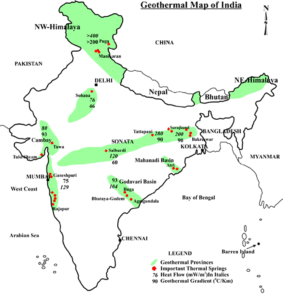 About Geothermal Energy –
About Geothermal Energy –
- Geothermal energy harnesses the Earth’s heat from hot springs or underground reservoirs, using steam to generate electricity.
- It can also provide heating, cooling, greenhouse support, and aquaculture benefits.
- The Geological Survey of India (GSI) has identified 381 hot springs with surface temperatures of 35°C to 89°C.
- How it Works: The Process —
- The process of harnessing geothermal energy typically involves drilling wells to access underground reservoirs of hot water and steam, known as hydrothermal resources.
- The most common method for generating electricity from these resources involves a few key steps —
- Extraction: Wells are drilled deep into the Earth to tap into geothermal reservoirs.
- Conversion: The hot water or steam is brought to the surface. In a dry steam plant, the steam is used directly to spin a turbine. In a flash steam plant, high-pressure hot water is converted to steam in a “flash tank” before it turns the turbine.
- Electricity Generation: The spinning turbine is connected to a generator, which converts the mechanical energy into electricity.
- Reinjection: The cooled water or condensed steam is then pumped back into the geothermal reservoir, a crucial step for maintaining the pressure and sustainability of the resource.
India’s Geothermal Potential –
- India’s estimated geothermal potential is 10.6 GW, with major sites in the Himalayan Geothermal Province (Uttarakhand, Himachal Pradesh, Ladakh, Jammu and Kashmir, Arunachal Pradesh), the Cambay Graben in Gujarat, and the Andaman and Nicobar Islands.
- Abandoned oil wells in Cambay and Gandhar (ONGC, Gujarat) are being considered for geothermal use.
- Global Geothermal Capacity —
- Globally, geothermal capacity is less than 17 GW, dominated by the US, Indonesia, and the Philippines, while Iceland and Norway lead in technology innovation.
- The US International Trade Administration identified Ladakh’s Puga and Chumathang fields as India’s most promising.
- According to the International Energy Agency (IEA), China, the US, and India account for 75% of next-generation geothermal potential, with India’s capacity projected to reach 4.2 GW by 2035 and nearly 100 GW by 2045.
India’s Geothermal Energy Push –
- The Ministry of New and Renewable Energy (MNRE) launched its geothermal energy policy, to promote exploration and development.
- Companies from Norway and Iceland have begun pilot studies in the Gulf of Cambay, Arunachal
Pradesh, and Uttarakhand.
- Collaborations with the US and Indonesia are also being explored, especially for enhanced geothermal systems suited for large-scale power plants.
- Potential Benefits in Remote Areas —
- According to the policy, geothermal energy can transform energy access in remote regions.
- In the Andaman and Nicobar Islands, where electricity costs ₹30–32 per unit, geothermal could reduce costs to ₹10–11 per unit.
- In Ladakh, it could supply both heating and electricity during extreme winters.
- Repurposing Oil Wells —
- India has thousands of abandoned oil wells, particularly in the Gulf of Cambay, which can be repurposed for geothermal use.
- Oil and gas firms are showing interest: IIT Madras is piloting a 450 kWh project in Barmer, Rajasthan, with support from MNRE and Vedanta’s Cairn Oil & Gas.
- Reliance Industries also plans to expand into geothermal through its oil and gas business.
- Challenges and Policy Support —
- Geothermal projects face high upfront costs and exploration risks, with an estimated ₹36 crore required per megawatt of capacity.
- To address this, the National Policy on Geothermal Energy will support R&D, pilot projects, and coordination across stakeholders, including the Ministry of Petroleum and Natural Gas and state governments.
- A viability gap funding (VGF) scheme is also being considered.
- Ongoing Initiatives —
- MNRE has already sanctioned five projects, including one backed by Vedanta.
- With the new policy, it expects to expand this list.
- The policy follows the creation of an MNRE task force on geothermal energy (formed in August 2024) and aims to demonstrate commercial feasibility while building technical and financial frameworks for scaling up.
Global Innovation Index
According to the World Intellectual Property Organisation’s (WIPO) Global Innovation Index (GII) 2025, R&D growth fell to 2.9 per cent in 2024 and is projected to drop further to 2.3 per cent in 2025.
About Global Innovation Index –
- It is a ranking of countries as per their success and capacity in innovation.
- It was first time launched in 2007and has become the leading global benchmark for measuring and comparing innovation performance.
- It is recognised by the UN General Assembly as an authoritative reference for Science, Technology and Innovation (STI) policies.
- It is published yearly by the World Intellectual Property Organisation (WIPO).
- It tracks global innovation trends through investment patterns, technological progress, adoption rates, and socioeconomic impacts.
- Significance — It provides a useful resource for government, industry, researchers and anyone with a stake in developing innovation ecosystems around the world
Key highlights of the Global Innovation Index 2025 –
- Top 5 Innovators: For the 15th consecutive year, Switzerland ranks first, followed by Sweden in second, the United States in third, the Republic of Korea in fourth, and Singapore in fifth.
- New Entrants and Rising Stars: China has entered the top 10 for the first time, securing the 10th position and leading all middle-income economies.
- Other countries like India, Türkiye, Vietnam, and Morocco are noted for their upward mobility in the rankings.
- India has risen to 38th place among 139 economies in the Global Innovation Index (GII) 2025, a remarkable improvement from its 81st rank in 2015.
United Nations Human Rights Council
Recently, India defended Qatar’s sovereignty at the United Nations Human Rights Council (UNHRC).
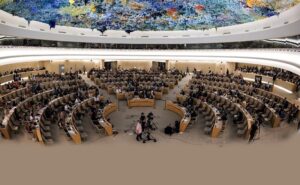 About United Nations Human Rights Council –
About United Nations Human Rights Council –
- It was created by the General Assembly on 15 March 2006 by replacing the Commission on Human Rights.
- It is an inter-governmental body within the United Nations system, which is responsible for strengthening the promotion and protection of human rights around the world.
- Mandate — To promote “universal respect for the protection of all human rights and fundamental freedoms for all” and “address situations of violations of human rights, including gross and systematic violations, and make recommendations thereon.”
- Member countries — The Council is made up of 47 Member States, which are elected by the UN General Assembly through direct and secret ballot.
- The Council’s Membership is based on equitable geographical distribution.
- Members of the Council serve for a period of three years and are not eligible for immediate re-election after serving two consecutive terms.
- Functions of United Nations Human Rights Council —
- It investigates allegations of breaches of human rights in UN member states.
- It addresses important human rights issues such as freedom of expression, women’s rights, LGBT rights, and the rights of racial and ethnic minorities.
- The UNHRC works closely with the Office of the High Commissioner for Human Rights (OHCHR).
Japanese Encephalitis
Researchers have found that waning immunity against infections of the Japanese encephalitis virus (JEV) can predispose individuals to more severe dengue.
About Japanese Encephalitis –
- It is a viral zoonotic disease caused by the Japanese Encephalitis(B) virus.
- Japanese encephalitis virus (JEV) is a flavivirus related to dengue, yellow fever and West Nile viruses.
- Transmission of Japanese Encephalitis —
- The virus is transmitted to humans by the infected Culex mosquito of the Vishnui group.
- There is no human-to-human transmission of the virus.
- It is most common in rural areas of Asia, particularly during monsoon seasons when mosquito breeding is prevalent.
- Both Japanese encephalitis virus and dengue virus belong to the same genus, Symptoms of Japanese Encephalitis —
- It affects the brain, leading to symptoms like fever, headache, vomiting, and neurological signs such as confusion, seizures, and paralysis.
- While many infected individuals may show mild or no symptoms, severe cases can lead to permanent brain damage or death.
- Prevention and Treatment for Japanese Encephalitis —
- There is no antiviral treatment for patients with JE. Treatment is supportive and includes stabilisation and relief of symptoms.
- Vaccination is the most effective prevention strategy, particularly in endemic regions.
- According to the Government of India’s guidelines, two doses of the vaccine have been a part of the Universal Immunisation Programme since 2013.
-
Hathei Chilli
Recently, 14th Sirarakhong Hathei Chilli Festival was inaugurated in Manipur to promote GI-Tagged Hathei Chilli.
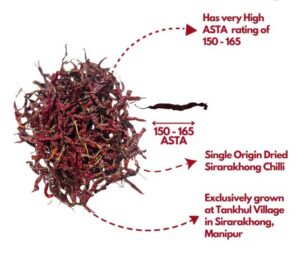 About Hathei Chilli –
About Hathei Chilli –
- It is commonly known as the Sirarakhong chilly.
- It thrives well only in the climatic condition of the Sirarakhong village, which is situated about 66 km from Imphal, Manipur.
- This indigenous chilli variety is cultivated under the jhum system on the slopes.
- Features of Hathei Chilli —
- It is one of the best varieties of chilli in the world and its distinctive colour, taste, size and shape is typical of the variety grown in Sirarakhong village.
- It has a high demand both inside and outside the state for its deep red colour and special taste.
- Its cultivation serves as the main source of income for residents of Tangkhul Nagadominated Sirarakong village
- It has an extremely high American Spice Trade Association (ASTA) colour value of 164. (The extractable colour of chilli is usually expressed using ASTA values).
- Health Benefits: It works as a good anti-oxidant and possesses high calcium and Vitamin C levels.
- This chilli received the Geographical Indication Tag (GI) in 2021.
What is a Geographical Indications Tag?
- The geographical origin of a product is indicated by a GI tag.
- It is given to foods, handicrafts, industrial items, wine and spirits, and agricultural products.
- The Geographical Indications of Goods (Registration and Protection) Act of 1999 mandates the use of GI tags.
- They are granted by the Geographical Indication Registry, which is part of the Ministry of
Commerce and Industry’s Department of Industry Promotion and Internal Trade.
PM MITRA Park
The Prime Minister recently laid the foundation stone of the country’s first Pradhan Mantri Mega Integrated Textile Region and Apparel (PM MITRA) Park in Madhya Pradesh’s Dhar District.
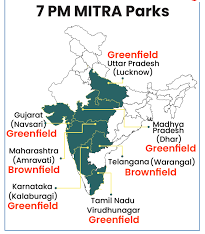 Pradhan Mantri Mega Integrated Textile Region and Apparel (PM MITRA) is a mega textile hub that brings every step of textile production, like spinning, weaving, dyeing, printing, and garment-making, into one single place.
Pradhan Mantri Mega Integrated Textile Region and Apparel (PM MITRA) is a mega textile hub that brings every step of textile production, like spinning, weaving, dyeing, printing, and garment-making, into one single place.- Each park covers a large area (about 1,000 acres or more) and acts as a complete ecosystem for textile manufacture.
- MITRA parks can be either Greenfield or Brownfield.
- The scheme is inspired by the vision “Farm to Fibre to Factory to Fashion to Foreign” and aims to make Indian textiles cheaper, faster to market, and of higher quality. Nodal Ministry: Ministry of Textiles
• Features —
- Integrated Value Chain — Each park brings spinning, garmenting, dyeing, and processing into a single zone, cutting transport time and costs.
- World-Class Infrastructure —
- The parks have modern roads, reliable power and water, worker hostels, logistics, and plug-and-play factory units, with space for research, skill training, and commercial activity.
- PM MITRA will develop 50% area for pure Manufacturing Activity, 20% area for utilities, and 10% of area for commercial development.
- Jobs and Investment — Each park is expected to create 1 lakh direct and 2 lakh indirect jobs. The project aims to attract over Rs 70,000 crore in investments.
- Public–Private Partnership — PM MITRA park will be developed by a Special Purpose
Vehicle (SPV) which will be owned by the State Government and the Government of India in a Public-Private Partnership (PPP) Mode.
- Capital and Incentives —
- The Ministry of Textiles will provide financial assistance up to Rs 800 crores per park for Greenfield projects and up to Rs 500 crores per park for Brownfield projects.
- The State Governments will provide land and augmented utility infrastructure for the proposed mega textile parks.
- Where are the PM MITRA Parks? The seven approved PM Mitra Parks are being set up in:
- Tamil Nadu (Virudhunagar)
- Telangana
- Gujarat
- Karnataka
- Madhya Pradesh
- Uttar Pradesh (Lucknow district) Maharashtra.
Directorate of Revenue Intelligence (DRI)
As part of ongoing pan-India “Operation Weed Out”, the Directorate of Revenue Intelligence (DRI) has seized 39.2 kg of hydroponic weed at Chhatrapati Shivaji Maharaj International Airport, Mumbai, recently.
About Directorate of Revenue Intelligence (DRI) –
- DRI was constituted in 1957 as the apex anti-smuggling intelligence and investigation agency.
- It works under the Central Board of Indirect Taxes & Customs (CBIC), Ministry of Finance, Government of India.
- DRI enforces the provisions of the Customs Act, 1962, and over fifty other allied acts, including the Arms Act, NDPS Act, COFEPOSA (Conservation of Foreign Exchange and Prevention of Smuggling Activities), Wildlife Act, Antiquities Act,
- It is tasked with detecting and curbing smuggling of contraband, including drug trafficking and illicit international trade in wildlife and environmentally sensitive items, as well as combating commercial frauds related to international trade and evasion of customs duty.
- It has a country-wide network of zonal, regional, and sub-regional units and intelligence cells.
- DRI collects, analyses, and disseminates intelligence to the field formations, helps in investigations, and keeps statistics of seizures and prices/rates, etc, for watching trends of smuggling and movement of other contraband and suggest remedies for fixing loopholes in existing laws and procedures.
- The DRI has also been designated as the lead agency for S-CORD, the national antismuggling coordination centre.
- DRI has also been at the forefront in international Customs collaboration through Customs Mutual Assistance Agreements of CBIC with over 60 other countries, where the thrust is on information exchange and learning from the best practices of other Customs administrations.
Draft Civil Drone (Promotion and Regulation) Bill, 2025
The Ministry of Civil Aviation recently made public the Draft Civil Drone (Promotion and Regulation) Bill, 2025, and invited feedback from stakeholders and citizens.
 About Draft Civil Drone (Promotion and Regulation Bill) 2025 –
About Draft Civil Drone (Promotion and Regulation Bill) 2025 –
- Released by the Ministry of Civil Aviation, the Draft Civil Drone (Promotion and Regulation Bill) 2025 proposed provisions such as mandatory registration, safety and security features, as well as insurance, amongst other requirements for unmanned aircraft systems’ (UASs) operations in the country.
- The law covers individuals and entities engaged in drone ownership, operation, design, manufacture, import, export, leasing, training or maintenance, but excludes unmanned aircraft used by the armed forces or those weighing over 500 kilograms, which will be governed under the Bharatiya Vayuyan Adhiniyam.
• DGCA Retained as Regulator —
- It retains the Directorate General of Civil Aviation (DGCA) as the primary regulatory authority.
- The draft mandates that no drone will be allowed to operate without registration and issuance of a Unique Identification Number (UIN) by the DGCA.
- Similarly, manufacturers would be required to obtain a type certification from DGCA before their drones can be sold or operated in India.
• Safety, Security Features Compulsory —
- No person shall manufacture or assemble, offer for sale, transfer or cause to transfer, operate or cause to operate any UAS that does not incorporate the mandatory safety and security features as prescribed by the central government or unless the UAS is exempted from such requirement.
- These features are intended to ensure airworthiness, prevent tampering, and enable traceability of drone operations.
• Compulsory Insurance for Operators —
- Notably, provision for insurance has been made compulsory, with third-party coverage required for all operators unless specifically exempted by the government.
- The insurance company shall, upon receiving information of the accident, either from the claimant or through an accident information report or otherwise, designate an officer to settle the claims relating to such accident.
• Digital Sky Zones Retained —
- Draft retains the concept of a ‘Digital Sky’ online platform of zoning that will segregate skies into green, yellow, and red zones.
- While operations in green zones will be freely permitted, flying in yellow zones will require clearance from air traffic control.
- No person shall operate an UAS in a red zone without prior permission from the central government and the red zone creating agencies.
- Violations in restricted airspace have been classified as cognisable and noncompoundable offences, attracting up to three years’ imprisonment or fines extending to ₹1 lakh.
- Compensation for Victims Proposed: The owner of the UAS or the authorised insurer shall be liable to pay, in the case of death or grievous hurt due to any accident arising out of the use of unmanned aircraft system, a compensation of a sum of 2.5 lakh rupees in case of death or one lakh rupees in case of grievous hurt to the legal heirs or the victim, as the case may be.
- Claim Tribunals to Handle Drone Cases: The ‘Motor Accident Claim Tribunals’ has been proposed to be designated as the claim tribunal for the purpose of adjudicating upon claims for compensation in respect of accidents involving the use of UASs. • Punishment —
- Any person who contravenes the provisions of this Act shall be punishable with a fine up to ₹50,000 or an imprisonment which may extend to three months or both, and for any second or subsequent offence with a fine up to ₹1 lakh or an imprisonment which may extend to six months or both.
- Any offence involving carriage of dangerous goods by a civil UAS, or use of a civil UAS as a weapon, shall be cognizable and non-compoundable.
- The Director General or any other officer authorised in this behalf may seize and confiscate the UAS, documents, records, devices or things which may be useful for, or relevant to, the investigation of such offence.
National Tiger Conservation Authority (NTCA)
The Supreme Court recently sought responses from the Centre, the National Tiger Conservation Authority (NTCA), and others on a PIL seeking a CBI probe into an alleged organised tigerpoaching and illegal wildlife-trade racket operating in states like Maharashtra and Madhya Pradesh.
 About National Tiger Conservation Authority (NTCA) –
About National Tiger Conservation Authority (NTCA) –
- It is a statutory body under the Ministry of Environment, Forest, and Climate Change (MoEFCC).
- It was established in 2006 under the Wildlife (Protection) Act 1972 (WPA 1972).
• Objectives —
- Providing statutory authority to Project Tiger so that compliance with its directives becomes legal.
- The ‘Project Tiger’ is a Centrally Sponsored Scheme (CSS) of the Ministry of Environment, Forests and Climate Change, providing funding support to tiger range States for in-situ conservation of tigers in designated tiger reserves.
- Fostering accountability of the Centre-State in the management of Tiger Reserves by providing a basis for MoU with States within the federal structure.
- Providing for an oversight by Parliament.
- Addressing livelihood interests of local people in areas surrounding Tiger Reserves.
• NTCA Composition —
- Minister in charge of MoEFCC (as Chairperson),
- Minister of State in MoEFCC (as Vice-Chairperson),
- three members of Parliament, the Secretary (MoEFCC), and other members.
• Power and Functions —
- Powers and functions of the NTCA as prescribed under the WPA 1972, as amended in 2006, are as under:
- to approve the tiger conservation plan prepared by the State Government.
- evaluate and assess various aspects of sustainable ecology and disallow any ecologically unsustainable land use, such as, mining, industry, and other projects within the tiger reserves.
- lay down normative standards for tourism activities and guidelines for Project Tiger from time to time for tiger conservation in the buffer and core area of tiger reserves and ensure their due compliance.
- provide for management focus and measures for addressing conflicts of men and wild animals and to emphasise coexistence in forest areas outside the National Parks, sanctuaries, or tiger reserves, in the working plan code.
- provide information on protection measures, including future conservation plans, estimation of the population of tiger and their natural prey species, status of habitats, disease surveillance, mortality surveys, patrolling, reports on untoward happenings, and such other management aspects as it may deem fit, including future conservation plans.
- Approve and coordinate research and monitoring on tigers, co-predators, prey habitat, related ecological and socio-economic parameters, and their evaluation.
- ensure that the tiger reserves and areas linking one protected area or tiger reserve with another protected area or tiger reserve are not diverted for ecologically unsustainable uses, except in the public interest and with the approval of the National Board for Wild Life and on the advice of the NTCA.
- facilitate and support the tiger reserve management in the State for biodiversity conservation initiatives through eco-development and people’s participation as per approved management plans and to support similar initiatives in adjoining areas consistent with the Central and State laws.
- ensure critical support, including scientific, information technology, and legal support, for better implementation of the tiger conservation plan.
- facilitate ongoing capacity building programme for skill development of officers and staff of tiger reserves, and
- perform such other functions as may be necessary to carry out the purposes of this Act with regard to conservation of tigers and their habitat.
- The NTCA may, in the exercise of its powers and performance of its functions under this Chapter, issue directions in writing to any person, officer or authority for the protection of tiger or tiger reserves and such person, officer or authority shall be bound to comply with the directions.
MCQs
- Which of the following statement(s) is/are incorrect about the ‘World Intellectual Property Organisation’?
- It is one of the specialised agencies of the World Trade Organisation.
- All member states of the World Trade Organisation are obliged to become members of the WIPO.
- India is the founding member of the WIPO.
Select the correct codes from below –
- 1 and 2 only
- 2 and 3 only
- 1 and 3 only
- All of the above
Answer – D
Explanation – All statements are incorrect. WIPO is one of the oldest specialised agencies of United Nations. WIPO was created in 1967 “to encourage creative activity, to promote the protection of intellectual property throughout the world”. WIPO currently administers 26 international treaties. It is headquartered in Geneva, Switzerland. Every year World Intellectual Property Day is being celebrated on 26th April. All member states of the UN are entitled, though not obliged, to become members of the specialised agencies like WIPO. India became a member of WIPO in 1975. WIPO’s activities include hosting forums to discuss and shape international IP rules and policies, providing global services that register and protect IP in different countries, resolving transboundary IP disputes, helping connect IP systems through uniform standards and infrastructure, and serving as a general reference database on all IP matters.
- Consider the following statements with reference to the Bima Sugam Portal –
- It has been launched by the Insurance Regulatory and Development Authority of India (IRDAI) as a unified marketplace for multiple types of insurance.
- It provides end-to-end services including purchase, renewal, management, and claim settlement of insurance policies.
- Unlike private aggregators, it is managed by the Bima Sugam India Federation (BSIF), in which all insurance companies are stakeholders.
- It has been modelled on the lines of UPI by creating a common digital infrastructure for the insurance sector.
Which of the statements given above are correct?
- 1 and 2 only
- 1, 2 and 3 only
- 2, 3 and 4 only
- All of the above
Answer – D
Explanation – Launched by IRDAI, Bima Sugam is being hailed as a groundbreaking initiative, unmatched in scale worldwide. Unlike other countries’ digital channels, it offers a single, unified marketplace for all insurance needs—life, health, motor, travel, property, and agricultural policies —on one platform. Bima Sugam allows users to buy, sell, renew, manage, and claim insurance policies with ease and full transparency. Policy documents will be securely stored, ensuring easy access. It aims to do for insurance what UPI and NPCI have done for digital payments by creating common infrastructure for all stakeholders. The platform charges minimal fees and has all insurance companies as members, many of whom also hold equity stakes in the Bima Sugam India Federation (BSIF), which manages the system. Unlike private aggregators such as PolicyBazaar, which mainly distribute policies and earn high commissions, Bima Sugam offers end-to-end services including claim settlement, making it a low-cost, integrated, and transparent alternative.
- Which of the following is/are true about Geothermal Energy?
- The National Building Code 2016 has included geo-thermal cooling and heating as one of the energy efficient options.
- India has low geothermal potential.
Select the correct codes from below –
- 1 only
- 2 only
- Both 1 and 2
- Neither 1 nor 2
Answer – C
Explanation – Geothermal Energy is heat stored in earth crust and being used for electric generation and also for direct heat application worldwide since beginning of last century. Geothermal electricity generation is site and technology specific and India is in Low Geothermal Potential Region with low/medium heat enthalpy. The National Building Code 2016 has included new and energy efficient options of air conditioning, heating and mechanical ventilation, such as variable refrigerant flow system, inverter technology, district cooling system, hybrid central plant using chilled beams, radiant floor components, and geo-thermal cooling and heating.
- Which of the following statement(s) is/are correct about the ‘UN Human Rights Council’?
- It is a United Nations body founded in the year 1950 after the signing of the UN Declaration of Human Rights in 1948 to promote and protect human rights around the world.
- All the members of the United Nations Generally Assembly vote to elect the 47 members of the UNHRC.
- A member serves a period of three years and is not eligible for immediate re-election after serving two consecutive terms.
Select the correct codes from below –
- 1 and 2 only
- 2 and 3 only
- 1 and 3 only
- All of the above
Answer – B
Explanation – The United Nations Human Rights Council (UNHRC) is a United Nations body whose mission is to promote and protect human rights around the world. The UNHRC has 47 members elected for staggered three-year terms on a regional group basis from 5 groups. To become a member, a country must receive the votes of at least 96 of the 191 states of the UN General Assembly (an absolute majority). The members are elected for a period of three years, with a maximum of two consecutive terms. In electing Council members, the resolution provides that General Assembly members “shall take into account the candidates’ contribution to the promotion and protection of human rights and their voluntary pledges and commitments made thereto.” The UNHRC holds regular sessions three times a year, in March, June, and September. Members serve for a period of three years and are not eligible for immediate re-election after serving two consecutive terms. The elections are held amongst the members of the United Nations General Assembly to elect the members of the UNHRC.
- Which of the following statement(s) is/are correct about the ‘Japanese Encephalitis’?
- The term ‘encephalitides’ means dehydration of the body.
- It is a mosquito-flavivirus disease which is found across south and east areas of Asia.
- In India, Uttar Pradesh contributed more than 75% of JE cases during the recent past.
Select the correct codes from below –
- 1 and 2 only
- 2 and 3 only
- 1 and 3 only
- All of the above
Answer – B
Explanation – Japanese encephalitis (JE) is one of the most common encephalitides (inflammation of the brain) worldwide. The disease is caused by a mosquito-borne flavivirus and is found across south and east areas of Asia. It is a zoonosis – an animal disease that can spread to humans. JE virus is transmitted to humans through the bite of infected Culex mosquitoes, which lay their eggs in irrigated rice paddies and other pools of stagnant water. Pigs and birds serve as amplifying vertebrate hosts. Humans are believed to be dead-end hosts. The disease outbreak usually occurs during the rainy season. Case-fatality rate in severe clinical cases is estimated to be 20–30%, with young children (< 10 years) having a greater risk of severe disease and death.
The first case in India was reported in 1955 but the disease was restricted to south India. In India, while 24 states are endemic for JE, Uttar Pradesh contributed more than 75% of cases during the recent past.
Source – The Indian Express

